Camphora officinarum
Camphora officinarum Boerh. ex Fabr. (= Cinnamomum camphora (L.) J.Presl)
Family: Lauraceae
Common names: camphor tree, camphor laurel (Eng.); kanferboom (Afr.); ulosilina (isiZulu)
Introduction
The camphor tree is a large, evergree tree with a dense canopy of glossy, light green leaves, sprays of small white to pale yellow flowers in spring and small, black fleshy berries in summer. Leaves and branches give off a strong camphor scent when crushed or broken and are used medicinally.
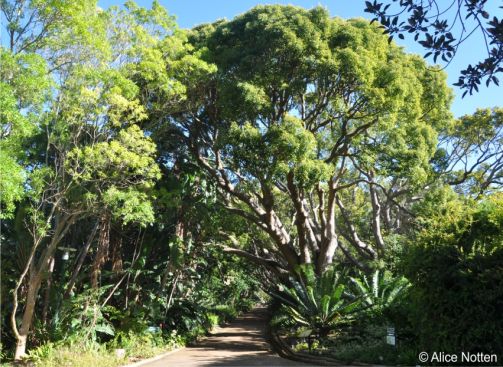
Description
Description
Camphora officinarum is a large, spreading evergreen tree that can reach up to about 25 m tall. The trunk is large and stout, the bark is rough, scaly or fissured and aromatic. Leaves are spiralled, egg-shaped to elliptic with a pointed tip, 3-veined from the base, bright light green, blue-grey from below, camphor scented when crushed.
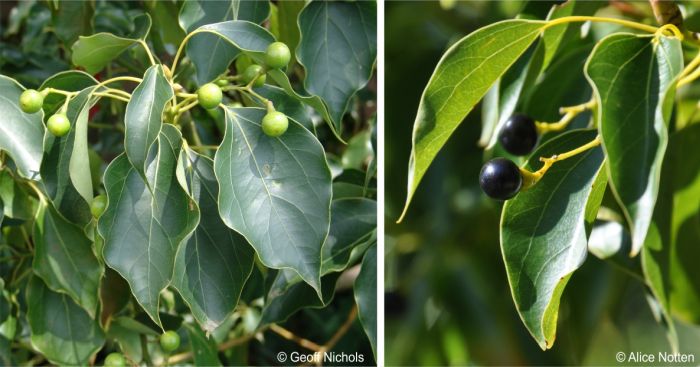
Flowers are small, white or pale yellow, in branched sprays in spring to early summer (September to November). Fruit is a small, fleshy drupe containing a single seed, black when mature, on the trees during summer and autumn (December to May).
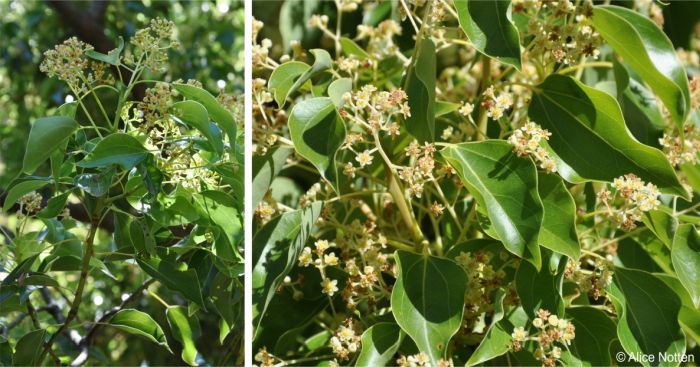
Conservation Status
Status
Camphora officinarum is an introduced species in South Africa and thus not evaluated for the Red List of South African Plants. It has naturalised in parts of South Africa and is listed as a Category 1b invasive species in KwaZulu-Natal, Mpumalanga, Limpopo and Eastern Cape, and as a Category 3 invasive species in the Western Cape.
Distribution and habitat
Distribution description
Camphora officinarum occurs naturally in warm temperate to subtropical regions of eastern Asia, including China, Korea, Japan, Taiwan and Vietnam. It was introduced to South Africa, and many other countries, as an ornamental and for timber and medicinal use. In South Africa it has naturalised in parts of KwaZulu-Natal, Mpumalanga, Limpopo, Eastern and Western Cape, growing in forest and forest margin. It has also naturalised in Australia, southern USA, southern Europe, eastern Africa and Madagascar and is invasive in parts of Kenya and Tanzania.
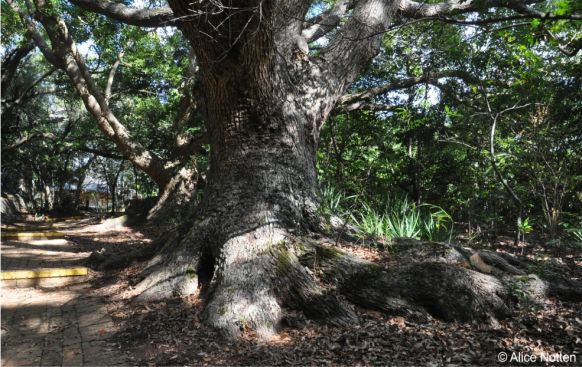
Derivation of name and historical aspects
History
The genus name Camphora is the Latin form of ‘camphor’ and the species name officinarum means that this is the species used in the manufacture of Camphor. This species was previously known as Cinnamomum camphora, but when molecular studies showed that the old concept of Cinnamomum was not monophyletic, and could be separated into two clades, the genus was split into two genera: Cinnamomum and Camphora. Camphora is a genus of about 20 species, and Cinnamomum is now a genus of about 225 species. Both belong in the Lauraceae, a family with a worldwide distribution and which also includes Laurel (Laurus nobilis), Avocado (Persea americana) and Stinkwood (Ocotea bullata).
The camphor trees in Kirstenbosch were planted in 1898, before it was proclaimed a botanical garden in 1913. Cecil John Rhodes planted an avenue of trees along his favourite ride from his residence in Newlands to Constantia Nek, choosing species from various parts of the British Empire. This track became Rhodes Drive. The section of Rhodes Drive that runs through Kirstenbosch includes an avenue of camphor trees (Camphora officinarum), and one of Moreton Bay figs (Ficus macrophylla) from Australia and stone pines (Pinus pinea) from southern Europe. Just south of the garden, in the direction of Hout Bay, the road is lined with Spanish chestnuts (Castanea sativa) and then cork oaks (Quercus suber). Because it has a steep gradient, making it difficult and dangerous to use during the wet season (before the road was tarred), the Camphor Avenue through Kirstenbosch was closed to vehicular traffic in 1916 and a deviation road was built to the east. Although the mandate for the National Botanical Gardens of South Africa is to grow only indigenous southern African species, the camphor trees of the Camphor Avenue were left in place as heritage trees.

Ecology
Ecology
Fruits are eaten and seeds spread by birds. The root system is dense and shallow. Trees coppice if lopped or damaged. Trees are long-lived, and are known to live up to 500 years or more. The trees prefer forest and forest margins, and riversides, and in the warm, well-watered eastern region of South Africa they are known to become naturalised and invade indigenous forests and outcompete native trees.
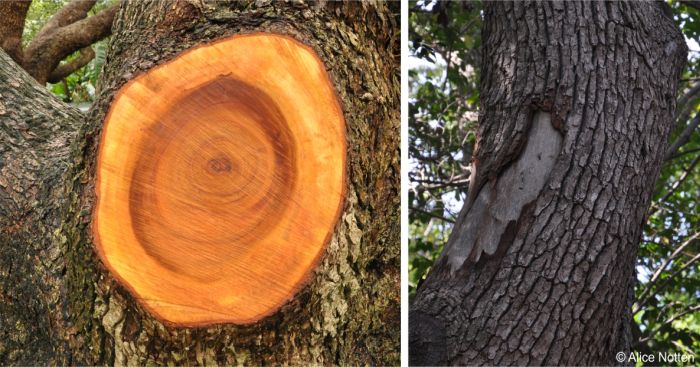
Uses
Use
Camphor can be extracted from the bark and wood, and camphor has been used for thousands of years as a spice, in incense, as an insect repellant and insecticide, and as a medicine, and the tree is used in traditional medicine in South Africa. Scars on the trunks left by harvesters scraping off large chunks of the bark are a common sight. The bark is used to treat muscle stiffness and as a topical antiseptic, and to treat fever, colds, flu and abdominal discomfort, in people and livestock. It is also used for its perfume and as a love charm. Camphor is toxic if taken in large quantities, causing nausea, vomiting, convulsions and respiratory failure, particularly in children.
The wood makes good timber that can be used for furniture, tables, turning and carving.
Many camphor trees have become well-loved, even revered heritage trees due to their longevity, stature and significant medicinal properties.
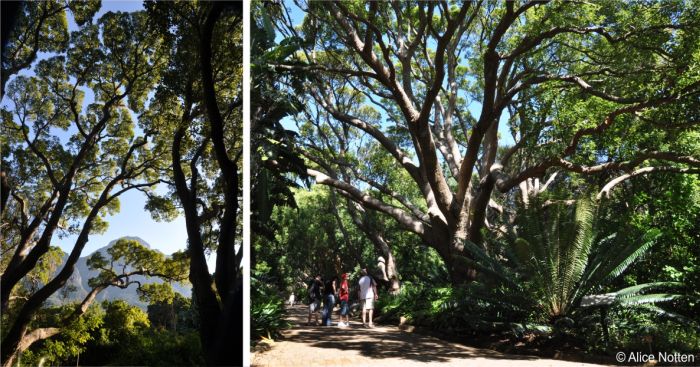
Growing Camphora officinarum
Grow
Camphor trees are not propagated or cultivated at Kirstenbosch. As a listed invasive species in South Africa, it should not be for sale in nurseries, nor may young plants be propagated and planted. In the Western Cape, existing trees may remain but new ones may not be planted.
References
- BioNET-EAFRINET. Keys and Fact Sheets. Cinnamomum camphora (Camphor Laurel). https://keys.lucidcentral.org/keys/v3/eafrinet/weeds/key/weeds/Media/Html/Cinnamomum_camphora_(Camphor_Laurel).htm. Accessed 10/06/2025.
- Boon, R. 2010. Pooley's trees of eastern South Africa, a complete guide. Flora & Fauna Publications Trust, Durban.
- Hutchings, A., Scott, A.H., Lewis, G. & Cunningham, A.B. 1996. Zulu medicinal plants: an inventory. University of Natal Press, Pietermaritzburg.
- Invasives South Africa. National list of invasive terrestrial and freshwater plant species. https://invasives.org.za/national-list-of-invasive-terrestrial-and-fresh-water-plant-species/. Accessed 10/06/2025.
- Plants of the World Online. Camphora officinarum Boerh. Ex Fabr. https://powo.science.kew.org/taxon/urn:lsid:ipni.org:names:77328940-1. Accessed 10/06/2025.
- Van Wyk, B.-E. & Gericke, N. 2000. People's plants, a guide to useful plants of southern Africa. Briza Publications, Pretoria.
- Wikipedia. Camphora officinarum. https://en.wikipedia.org/wiki/Camphora_officinarum. Accessed 10/06/2025.
- Yang, Z., Liu, B., Yang, Y. & Ferguson, D.K. 2022. Phylogeny and taxonomy of Cinnamomum (Lauraceae). Ecology and Evolution 12(10). DOI:10.1002/ece3.9378.
Credits
Alice Notten
Kirstenbosch National Botanical Garden
June 2025
Plant Attributes:
Plant Type: Tree
SA Distribution:
Soil type: Loam
Flowering season: Spring, Early Summer
PH:
Flower colour: White, Cream
Aspect: Full Sun
Gardening skill: Easy
Special Features:
Horticultural zones
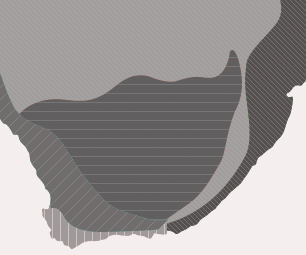







Rate this article
Article well written and informative
Rate this plant
Is this an interesting plant?
Login to add your Comment
Back to topNot registered yet? Click here to register.